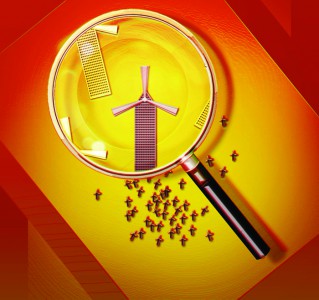Flash-charge no more!
Microscopic windmills capable of recharging electronic devices
By Amanda Gallo
Staff Writer

Kathleen Murray
Mobile device users have long endured the battle against the all-too-short battery life of their smartphones, tablets, cell phones and other mobile devices. Strict charging schedules and lugging around several different charging cables for those infamous 20 minute flash-charges have become the norm. However, a recent development by researchers at the University of Texas at Arlington could revolutionize the way we power our mobile devices.
The concept of using a windmill to generate the energy necessary to power our electronics is not exactly foreign, but these windmills are so small that their widest point measures only 1.8mm and ten of them can fit on a single grain of rice.
Designed by electrical engineering professor at U of Texas, Jung-Chih Chiao and research associate Smitha Rao, the windmills begin as two dimensional structures that are electroplated on a flat plane and then assembled into three dimensional structures using origami techniques. The durable and flexible nickel alloy from which they are crafted is designed to be both aerodynamic and resistant to strong winds without the possibility of fracture.
The device is useful because the amount of air required to power the windmills can come from something as simple as waving around a phone case studded with thousands of these micro-sized power generators for several minutes or letting the natural outdoor air spin the rotors in order to recharge a battery in a smartphone, for example. “Sometimes there’s not enough solar energy and sometimes you don’t have the connector available that can plug into the power outlet,” said Chiao in Michael Kwong’s article for CBC news.
While the researchers from the University of Texas cannot yet disclose how much energy a single microscopic windmill can generate due to a pending patent application, the various potential uses for this new technology are far-reaching: “We’ve only scratched the surface on how these micro-windmills might be used,” said Rao in a statement in Noah Rayman’s article for the New York Times.
According to Michelle Starr for CNET news, “Chiao added that the windmills could perhaps be crafted into panels of thousands, which could then be attached to the sides of buildings to harvest wind energy for lighting, security, or wireless communication.”
The new technology is still far from entering the public markets, as the researchers are currently investigating a potential friction problem with dust particles jamming the rotor blades.
The research has already captured the attention of Taiwanese tech company
WinMEMS. The company was responsible for the development of the fabrication
technique and, according to an article in the Business Insider, has
made a deal with the two researchers regarding commercialization
opportunities.
Category: Research & Technology


